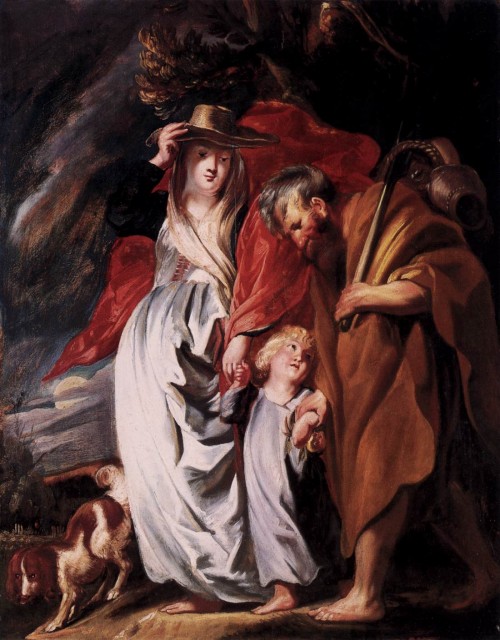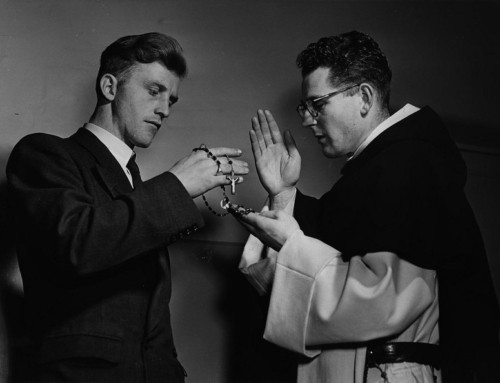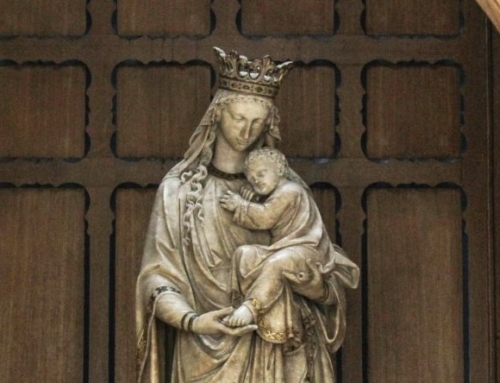Joseph sees the end of his day drawing to a close. He and his assistants are nearing completion on some cabinets and tables—putting the last touches of detail into an intricate project. As he sends his workmen off, he cleans up his shop noticing the sweat and dirt he has acquired from working with wood and tools. Just as he is putting the last of his tools away, Jesus, his Son, runs in to embrace him. Reaching down to the Child, Joseph picks Him up with his hands and holds Him in his arms. As he walks into the next room, he looks up and sees Mary, his wife, working on dinner. The house is filled with the aroma of a well prepared meal. Putting Jesus down, he comes to Mary and before a warm hug, with her gentle hands she wipes the sweat and dirt from his brow and washes away the work of the day from his tired body. At this, Joseph reaches for her hand and holds it tight—their fingers laced between each other’s as a sign of their perfect, chaste, and virginal love. They sit with one another in quiet repose, embracing a silent moment of rest and prayer. They give thanks to God for His many blessings, especially for the privilege and responsibility to raise His Son. Then, without a moment’s notice, their little One comes running to them, bringing them back to the reality of parenthood, gripping their hands with His little hands because He knows the strength of His mother and father.
Holding Hands in Another’s Arms
Holding hands is a beautiful thing, not simply because we find it comforting—whether it be between a man and a woman or a parent with their child—but because it is a sign of strength. Hands held together signify that someone is there to protect you, to keep you close, to never let you go. Of course, it is a sign of a communion of persons—just ask any teenage girl whose boyfriend reaches for her hand that first time or an older married couple who has spent years perfecting the craft of hand-holding. But in a deeper and more arresting way, holding hands communicates a strength that we all long for. It becomes a sign that we are in need of someone outside of ourselves: someone to help heal us when we are sick, comfort us when we are alone, and protect us from every danger. This little grace is a small piece in the puzzle of intimacy. In other words, something in the power of hands held together helps to make us whole again.
Jesus, raised by Mary and Joseph, knew personally this very power. The holy love of the Holy Family created an environment in which the sweet moments of grace were channeled through the gentlest of human touches, from the warm love that Mary and Joseph showed their infant Son in the manger to the bittersweet love of the sorrowful mother holding her Son’s limp body.
In the film The Passion of the Christ there is a powerful scene where Mary sits in shock as she sees her Son fall under the weight of the cross. Immediately, she recalls a memory of her young Son Jesus falling down while playing. She runs to Him, lifts Him up with her hands, and holds Him in her arms. This is a grace-filled memory that moves Mary to run to her Son—now under the cross—and hold Him with her hands, in her arms yet again. This compassionate touch reassures Him—who is Love—of the power and mercy of human touch.
The Merciful Effect of Touch
The effect of such a gentle and powerful touch undoubtedly reverberated throughout the ministry of Jesus. The powerful healings of the daughter of Jairus and the woman afflicted with a hemorrhage in the Gospel of Mark convey that Jesus knew all too well the power of hands (Mk 5:21–43). Jairus pleads to have Jesus lay His hands upon his sick daughter, to heal her with His touch. While Jesus moves through the crowd, an unnamed woman afflicted by a hemorrhage of twelve years sneaks up behind Him and puts her hand to His cloak. It is a grasp of last resort, for she had suffered greatly at the hands of many doctors who were unable to help her. The woman had given up on human hands—if only she could touch God with her hands: “If I but touch His clothes, I shall be cured” (Mk 5:28). It is Jesus, the God-man, that she touches. The grasp in faith that cures her—that sends power out from Jesus Himself, through His human touch—accompanies Jesus to the bedside of Jairus’ ailing daughter. He puts all the faithless people out of the room, and taking the little girl’s hand in His, commands her to get up. The little girl arises, immediately, at the touch of a hand. Perhaps recalling His own experience of the power of hands, Jesus communicates through His divine touch the merciful power of hands held together.
It is really mercy that defines the deep power of human touch. Whether it be the beautiful chaste embraces shared between Mary and Joseph that Jesus witnessed as a child or the gentle and confident hands with which Mary always cared for Him, there is a grace of Mary’s touch which becomes a mercy for us. We think of Mary as a Mother who watched her Child growing up: her pleasure in seeing His happiness, her pleasure in Him as He became a man. Mary—worshiping her Child, watching Him, holding Him, remembering Him—held all of Him within her heart. Every time she held His hand as they walked the streets of Nazareth they imaged a loving disposition.
Later, as she watched Him in His great agony and pain and as
she watched Him dying, what shined forth from the cross was His incredible mercy: “Father, forgive them, they know not what they do.” As she watched her Son, her sympathy and love for Him grew all the greater. She was touched in a new way, beyond the early days of her motherhood where she held Him in her arms. She was now touched with His pain and suffering, hurt when she saw His bodily pain, hurt as His body winced under its agony. In the most bitter of all moments, with a heart full of love and sympathy for Him, Mary sees us in her Son’s place: “Mother, behold your son.” Every connection she had to her Son, every touch she gave to Him, every time she held His hand, is now offered to us. As she once held His hand, and did so to the end, she now does for us. As she was moved by His joys, so now ours move her. As His sorrows touched her heart, so now ours take up their place within her depths. Like the little boy who gripped his merciful mother tight as she picked Him up off the ground, we grip her tight and allow her to lift us to herself.
A Song of a Mother’s Touch
Perhaps the most beautiful instance of hands knit together is the spiritual reality of an honest prayer, an unfiltered grasp for help. Sometimes it only takes reaching out to feel the hand of another waiting for yours. Often, there is little that we can do except send up an honest cry from the heart hoping for a response.
The famous musician Eric Clapton wrote of this phenomenon in his moving song “Holy Mother.” Wrapped in the chains of alcoholism, this song was the fruit of a desperate cry for help, a cry to a holy mother. In the midst of turmoil, Clapton fell into a moment of clarity. Clapton writes in his autobiography, “I was in complete despair. In the privacy of my room, I begged for help. I had no notion who I thought I was talking to, I just knew that I had come to the end of my tether . . . . and getting down on my knees, I surrendered.”
The lyrics of “Holy Mother” capture Clapton’s agony and desire for peace, with the images of holding hands and loving arms embodying his spiritual longing:
Holy mother, hear my prayer, somehow I know you’re still there / Send me please some peace of mind; take away this pain / . . . All I need is a hand to hold / Oh I feel the end has come, no longer my legs will run. You know I would rather be, in your arms tonight.
Like a son fallen at play, a cry for help calls a mother to his aid. Clapton’s prayer is the heart of the cross, and the merciful response of a mother’s touch calms his heart and gives him the confidence to move forward. As he writes about his condition a few days after uttering his prayer for help, “I had found a place to turn to, a place I’d always known was there but never really wanted, or needed, to believe in.” Even though Clapton did not write this song precisely as a prayer to Mary, it shows the power of a mother’s hand that reaches out and gives the strength, peace, and grace to move forward. Mary answers such prayers of her children with her maternal touch, which provides confidence and strength.
The Mercy of Confidence
In the end, we seek a hand because of a lack of something we need. Whether it is the hand of a spouse, a best friend, or the Blessed Mother, there is something more than comfort and consolation. It may feel good to hold hands and to be in the arms of another, but more importantly it imparts a merciful confidence—confidence in the love of another. When our spiritual hands meet those of Mary and Jesus, we become Joseph at home again from the carpenter’s shop. Wearied from another day’s work, it is the gentle hands of the greatest woman and the innocence of the greatest child that impart a confidence to our day. Our hearts are calloused, and it takes the touch of another to soften them through mercy. To make gentle souls out of stony hearts is a great work of mercy, and the hand of another can do this for us.
Mercy makes up for something that ought to be there, and in so many cases, mercy graces the world with a confidence in the love of God. To hold another’s hand is to know that person’s presence and strength. In the human touch of holding hands, something of divine love is shown to us. Even more so, to hold the hand of our mother in prayer is to know the Mother who held her Son and to experience intimately in ourselves the same love which she had for Him. Mary’s touch becomes a merciful reach towards God, keeping us close, protecting us, never letting us go. That is the confident grace of loving arms and hands held together.
To download a printable PDF of this Article from
Dominicana Journal, Winter 2015, Vol LVIII, No. 2, CLICK HERE.




